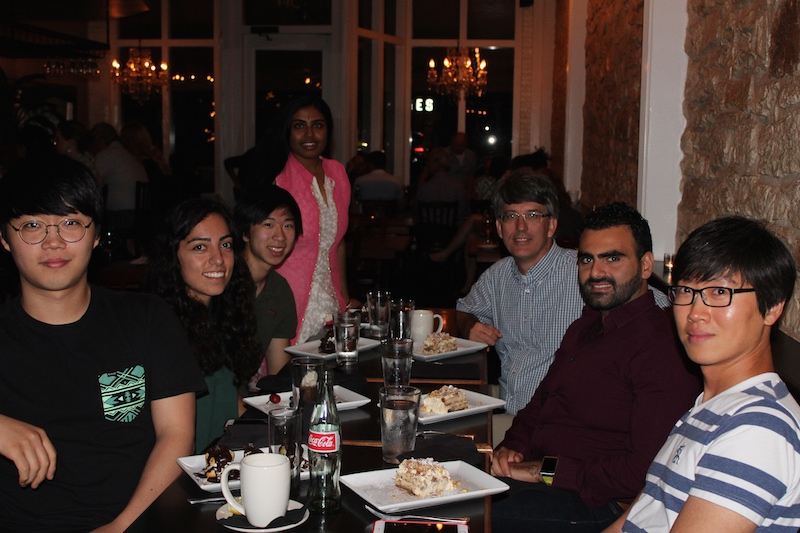
PhD Graduation Supper, May 11, 2016. From left to right: Jinseok Choi, Ghadi Sebaali, Jeremy Gin, Debarati Kundu, Brian Evans, Gilbert Badaro and Junmo Sung.
For more information contact: Debarati Kundu <kundu.debarati@gmail.com>
This dissertation was presented to the Faculty of the Graduate School of The University of Texas at Austin in partial fulfillment of the requirements for the degree of Ph.D. in Electrical Engineering
Abstract
Subjective and Objective Quality Evaluation of Synthetic and High Dynamic Range Images
Debarati Kundu, Ph.D.E.E.
The University of Texas at Austin, May 2016
Supervisor:
Prof.
Brian L. Evans
Defense Slides in PowerPoint and PDF formats
ESPL Synthetic Image Database - ESPL-LIVE High-Dynamic Range Image Database
ESPL Image/Video Quality Research - LIVE Image/Video Quality Research
Embedded Signal Processing Laboratory - Wireless Networking and Communications Group
Recent years have seen a huge growth in the acquisition, transmission, and storage of videos. The visual data consists of both natural scenes as well as synthetic scenes, such as animated movies, cartoons and video games. In all these cases, the ultimate goal is to provide the viewers with a satisfactory quality-of-experience. In addition to the traditional 8-bit images, high dynamic range imaging is also becoming popular because of its ability to represent the real world luminances more realistically. Coming up with objective image quality assessment algorithms for these applications is an interesting research problem.In this work, I have developed a synthetic image quality database by introducing varying degrees of different types of distortions and conducted a subjective experiment in order to obtain the ground-truth data. I evaluated the performance of state-of-the-art image quality assessment algorithms (typically meant for natural images) on this database, especially no-reference algorithms that have not been applied to the domain of computer graphics images before. I identified the top-performing algorithms along with analyzing the types of distortions on which the present algorithms show a less impressive performance.
For high dynamic range (HDR) images, I have designed two new full-reference image quality assessment algorithms to judge the quality of tonemapped HDR images using statistical features extracted from them. I have also conducted a massive on-line crowd-sourced subjective test for HDR image artifacts arising from tonemapping, multiple-exposure fusion and post processing. To the best of our knowledge, presently this is the largest HDR image database in the world involving the largest number of source images and most number of human evaluations. Based on the subjective evaluations obtained, I have also proposed machine learning based no-reference image quality assessment algorithms to predict the perceptual quality of HDR images.

PhD Graduation Supper, May 11, 2016. From left to right: Jinseok Choi, Ghadi Sebaali, Jeremy Gin, Debarati Kundu, Brian Evans, Gilbert Badaro and Junmo Sung.
For more information contact: Debarati Kundu <kundu.debarati@gmail.com>